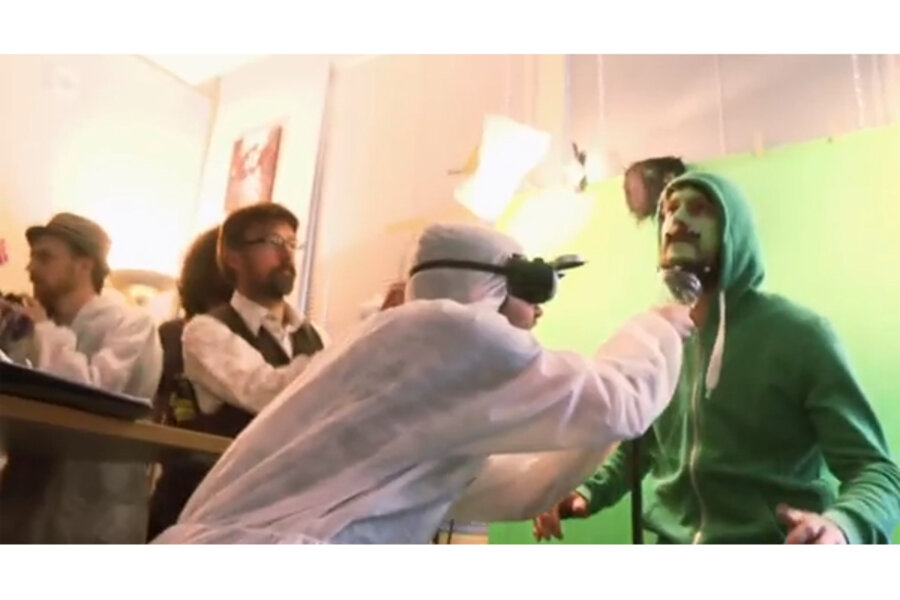As 'The Hobbit' premiere nears, the movie team works around the clock
Loading...
The newest behind-the-scenes “Hobbit” production video shows the team hard at work in the post-production phase of the first film, "The Hobbit: An Unexpected Journey."
“It’s due to be completed literally two days before the premiere,” director Peter Jackson says at the start of the video, then added with a chuckle, “Hopefully.”
Much of the video, explains Jackson, takes place at Park Road Post Production, the building in Wellington, New Zealand, that contains the facilities necessary to complete that specific part of the film process.
“This is where we’re spending a huge amount of time at the moment… You’re going to see a lot of sleep-deprived people in this blog,” Jackson said. “Everyone’s working around the clock.”
The video starts in the editorial section, which a sign labels “The Bunker" and which contains the cutting room where Jackson and editor Jabez Olssen work on cutting the second film in the planned trilogy.
The director describes his duties in the process with a tongue-in-cheek attitude.
“When Jabez has something very simple to do that doesn’t need me, I get the cups and go make a cup of tea,” Jackson said.
The viewer is then taken into the previs (or "previsualization") section of the post-production team, which deals with creating what previs production manager Marion Davey described as 3-D storyboards for the movie. These help Jackson create his shots for the film.
During the video, the previs team receives an order for an image called “Goblins slowly move torture machines towards the Great Goblin’s platform,” and an animated stopwatch ticks off the minutes as the team works.
Next, VFX supervisor Eric Saindon heads over to Wexford Road, the production office where the “Hobbit” animators work. At the office, animation supervisor Dave Clayton explains the process behind animating the sequence in which three hungry trolls threaten Bilbo (Martin Freeman), including the use of motion-capture technology so the movements of the actor playing one of the trolls could be used for the film.
“Are there any more of you little fellas hiding where you shouldn’t?” one of the trolls growls in footage from the film.
“No,” Freeman replies hastily, dangling as he’s held upside down by the troll.
Jackson explains that the field of motion-capture has made significant strides during production, which brings the cameras to the next stop on the tour: the Department of Internal Beard-Hairs. The men working in that department motion-capture beards to be added to the film, which involves creating a virtual beard, then adding motion-capture dots to an actor where the beard would go, and having them act as they would in the scene.
“Motivation here: it’s dark, it’s stormy, you’re in the mountains,” beard mocap technician Jance Rubinchik tells the actor, who then winces and looks uncomfortable as he would in such weather as the camera rolls.
Later at Wexford Road, two staff members “release the animators” as the first task of the day. When they knock, the door opens to reveal a group of people dressed in pajamas.
“If people don’t have to leave, we’re happy for them to stay,” Saindon says. Shots show crew members cooking eggs, doing laundry, and even getting massages.
Conceptual artists John Howe and Alan Lee are also shown hard at work, adding in backgrounds.
“We’re painfully conscious that behind us are considerable teams of people, waiting for artwork to do 3-D and the texturing and the lighting and the animation,” Howe said.
Director of photography Andrew Lesnie works on a sequence of the film in which Frodo (Elijah Wood) runs down the road as Bilbo (Ian Holm, in Bilbo’s older years) stands above him. Lesnie color-grades the sequence to clean it up and make it more attractive.
In the sound design department, one part of their work involves bringing friends and family to a field to scream and yell in fright – sounds which will be used as background for a dragon attack on a river village.
A red line on a map then zooms from New Zealand to the UK, where musicians are shown recording a bombastic part of the score of the film with lots of French horns and cellos in legendary recording studio Abbey Road.
“The premiere is very, very close, but fortunately, people are staying calm,” Jackson deadpans at the end of the video, followed by shots of people partying and fighting with ice cream and pillows.
Check out the full video.







